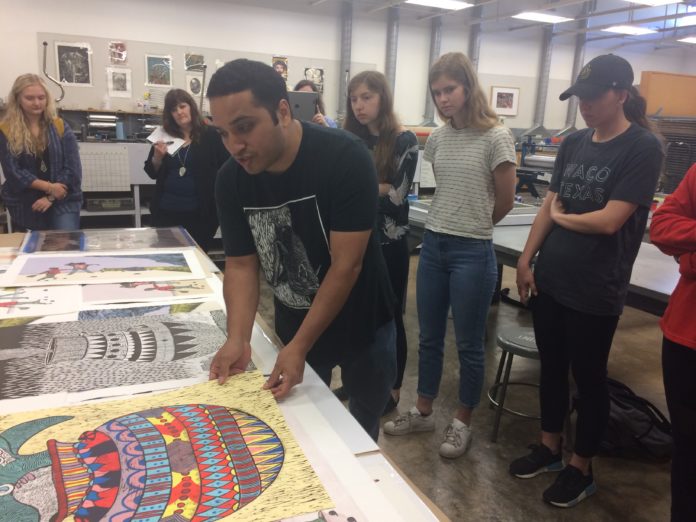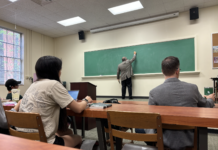By Emma Whitaker | Reporter
While a student’s academic energy may wane as finals season approaches, students’ creative energy never takes a break. The Department of Art and Art History invited Baylor alumnus Humberto Saenz to lecture and provide a printmaking demo to students this past week in Hooper Schaefer Fine Arts Center.
Saenz, who was an architecture major going into college changed his major to an art after a professor showed him the work of M. C. Escher, a renowned Dutch lithographer’s work.
Lithography is a process of printing artwork, where ink is repelled in any place it is not wanted. Humberto currently a professor at University of Texas at San Antonio and is the head of the graduate program for printmaking. His artwork has been displayed internationally.
Saenz challenged students to create art out of passion and justice, using symbolic language to create a story the viewer can understand. Piñatas are a main motif throughout Saenz’s work.
“Piñatas were very symbolic to me because it reminded me of my people. Piñatas are treated poorly, wacked with a stick even, yet beautiful things come out,” Saenz said.
Saenz accredits much of his inspiration to his father’s stories, to the handing down of stories. Saenz talked of his own relationship with his three children, and their influence on his work. One piece of art Saenz showed was covered in his children’s scribbles. Saenz decided that the scribbles should be kept.
“Somehow that work has been featured into more shows than all of my others. My children were getting something right,” Saenz said.
He even showed the room his full artwork whole series on food trucks.
“One day the food truck is in one part of town, and another day it’s on a different part of town, like a symbol of migration. It brings people together, and that’s what I wanted my paintings to symbolize,” Saenz said.
He even collaborates with engineers to make a conductive print, a print that was made with ink that produces electricity.
“When a participant touches the prints, the lights synchronize through different algorithms,” Saenz said.
His most recent work focuses on families being separated at the border. Many viewers asked Saenz how he could use such fun, bright colors for such serious themes.
“Aesthetics play a deep part is getting content across. Color carries a viewer into the work. If they like the color, they will come over and see what the work is about,” Saenz said.
Princeton senior Olivia Haskin loved the presentation, finding the electricity conducting prints fascinating.
“I loved it. I myself am an aspiring artist and was so encouraged that Saenz didn’t know exactly what he wanted to do and didn’t even realize his passion and interest for art until he was about our age,” Haskin said.






